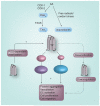Thromboxane and the thromboxane receptor in cardiovascular disease
- PMID: 20543887
- PMCID: PMC2882156
- DOI: 10.2217/clp.10.11
Thromboxane and the thromboxane receptor in cardiovascular disease
Abstract
Thromboxane A(2) (TXA(2)), the primary product of COX-1-dependent metabolism of arachidonic acid, mediates its biological actions through the TXA(2) receptor, termed the TP. Irreversible inhibition of platelet COX-1-derived TXA(2) with low-dose aspirin affords protection against primary and secondary vascular thrombotic events, underscoring the central role of TXA(2) as a platelet agonist in cardiovascular disease. The limitations associated with aspirin use include significant gastrointestinal toxicity, bleeding complications, potential interindividual response variability and poor efficacy in some disease states. This, together with the broad role of TXA(2) in cardiovascular disease beyond the platelet, has refocused interest towards additional TXA(2)-associated drug targets, in particular TXA(2) synthase and the TP. The superiority of these agents over low-dose aspirin, in terms of clinical efficacy, tolerability and commercial viability, remain open questions that are the focus of ongoing research.
Figures

Similar articles
-
Thromboxane receptors antagonists and/or synthase inhibitors.Handb Exp Pharmacol. 2012;(210):261-86. doi: 10.1007/978-3-642-29423-5_11. Handb Exp Pharmacol. 2012. PMID: 22918735 Review.
-
The thromboxane receptor antagonist S18886 but not aspirin inhibits atherogenesis in apo E-deficient mice: evidence that eicosanoids other than thromboxane contribute to atherosclerosis.Arterioscler Thromb Vasc Biol. 2000 Jul;20(7):1724-8. doi: 10.1161/01.atv.20.7.1724. Arterioscler Thromb Vasc Biol. 2000. PMID: 10894809
-
TP receptor activation and inhibition in atherothrombosis: the paradigm of diabetes mellitus.Intern Emerg Med. 2011 Jun;6(3):203-12. doi: 10.1007/s11739-010-0440-3. Epub 2010 Aug 24. Intern Emerg Med. 2011. PMID: 20734162 Review.
-
The thromboxane synthase and receptor signaling pathway in cancer: an emerging paradigm in cancer progression and metastasis.Cancer Metastasis Rev. 2011 Dec;30(3-4):397-408. doi: 10.1007/s10555-011-9297-9. Cancer Metastasis Rev. 2011. PMID: 22037941 Free PMC article. Review.
-
Novel angiotensin II AT(1) receptor antagonist irbesartan prevents thromboxane A(2)-induced vasoconstriction in canine coronary arteries and human platelet aggregation.J Pharmacol Exp Ther. 2000 Jan;292(1):238-46. J Pharmacol Exp Ther. 2000. PMID: 10604953
Cited by
-
Activated Platelets Induce Endothelial Cell Inflammatory Response in Psoriasis via COX-1.Arterioscler Thromb Vasc Biol. 2020 May;40(5):1340-1351. doi: 10.1161/ATVBAHA.119.314008. Epub 2020 Mar 5. Arterioscler Thromb Vasc Biol. 2020. PMID: 32131611 Free PMC article. Clinical Trial.
-
The human gut microbiome and aging.Gut Microbes. 2024 Jan-Dec;16(1):2359677. doi: 10.1080/19490976.2024.2359677. Epub 2024 Jun 3. Gut Microbes. 2024. PMID: 38831607 Free PMC article. Review.
-
Influence of Cardiometabolic Risk Factors on Platelet Function.Int J Mol Sci. 2020 Jan 17;21(2):623. doi: 10.3390/ijms21020623. Int J Mol Sci. 2020. PMID: 31963572 Free PMC article. Review.
-
Platelet activity and cardiovascular risk in apparently healthy individuals: a review of the data.J Thromb Thrombolysis. 2011 Aug;32(2):201-8. doi: 10.1007/s11239-011-0590-9. J Thromb Thrombolysis. 2011. PMID: 21562837 Review.
-
Association of Anabolic Steroid Use With Hypertension and Cardiomyopathy: A Case Study.Cureus. 2024 Oct 18;16(10):e71775. doi: 10.7759/cureus.71775. eCollection 2024 Oct. Cureus. 2024. PMID: 39559620 Free PMC article.
References
-
- Smyth EM, FitzGerald GA. Prostaglandin mediators. In: Bradshaw RA, Dennis EA, editors. Handbook of Cell Signaling. Second Edition Academic Press; UK: 2009. pp. 1219–1228.
-
- Hirata M, Hayashi Y, Ushikubi F, et al. Cloning and expression of cDNA for a human thromboxane A2 receptor. Nature. 1991;349:617–620. - PubMed
-
- Fitzgerald DJ, Roy L, Catella F, et al. Platelet activation in unstable coronary disease. N. Engl. J. Med. 1986;315:983–989. - PubMed
Grants and funding
LinkOut - more resources
Full Text Sources
Other Literature Sources
